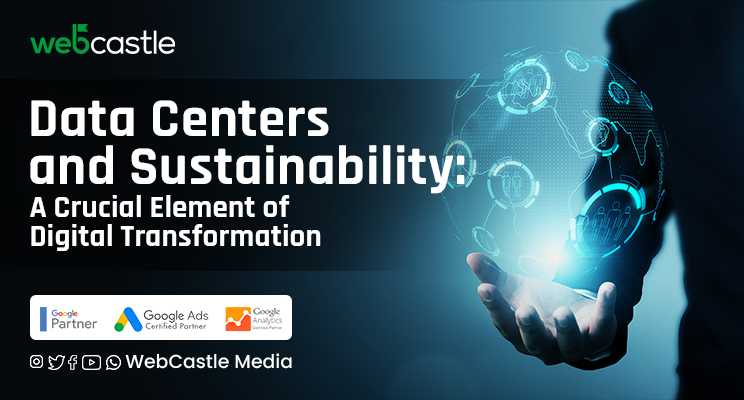
In an increasingly digital world, data centers play a pivotal role in supporting the infrastructure of our interconnected society. From streaming services to e-commerce, from healthcare to finance, nearly every aspect of modern life relies on these facilities to process, store, and transmit vast amounts of data. However, this digital revolution comes at a cost – a substantial environmental one. The energy consumption and carbon footprint of data centers have raised concerns about their sustainability. This blog delves into the critical nexus of data centers and sustainability, highlighting their significance in the context of digital transformation.
The advent of the internet and the proliferation of smart devices have triggered an unprecedented surge in data generation. Whether it’s the tweets we send, the videos we stream, or the records in healthcare databases, data is constantly being created and accessed. This surge in data has necessitated the existence and expansion of data centers.
Data centers are centralized facilities equipped with an array of servers, networking equipment, and storage systems. Their primary function is to store, manage, and process data for various applications and services. From social media giants like Facebook to cloud computing providers like Amazon Web Services, data centers are the unsung heroes of our digital age. As such, their significance cannot be overstated.
Digital transformation is the process by which organizations leverage technology to enhance their operations, customer experiences, and competitiveness. It encompasses a wide range of technologies, including artificial intelligence, the Internet of Things (IoT), big data analytics, and cloud computing. These technologies are instrumental in reshaping industries, streamlining processes, and driving innovation.
Data centers are essential to this transformation. They provide the necessary computing power, storage, and network connectivity that underpin digital initiatives. Whether a company is adopting machine learning to improve its products or migrating its operations to the cloud for scalability, data centers are indispensable. However, this digital revolution has an environmental downside – it consumes vast amounts of energy.
The Energy Challenge
Data centers are voracious consumers of electricity. The servers and cooling systems that keep them operational require massive amounts of energy. According to the U.S.Data centers in the United States alone utilized around 100 billion kilowatt-hours of electricity in 2020, according to the Environmental Protection Agency (EPA). To put this into perspective, that’s enough electricity to power all the households in New York City for two years.
The Carbon Footprint
The energy consumption of data centers not only strains power grids but also contributes significantly to carbon emissions. A report by the International Energy Agency (IEA) estimates that data centers and data transmission account for around 1% of global electricity consumption and emit roughly 0.3% of global CO2 emissions. These numbers might seem small compared to other industries, but they are growing rapidly as our reliance on digital services continues to expand.
The Environmental Imperative
Given their environmental impact, it is imperative that data centers take sustainability seriously. The good news is that the industry has been making strides in this direction. Several key strategies and technologies are being employed to reduce the environmental footprint of data centers.
Energy Efficiency
Improving energy efficiency is one of the primary ways to mitigate the environmental impact of data centers. This involves optimizing server utilization, upgrading to energy-efficient hardware, and implementing advanced cooling techniques. For example, many data centers are now using free cooling systems that leverage outside air to cool server rooms, reducing the need for energy-hungry air conditioning.
Renewable Energy
Transitioning to renewable energy sources is another critical step. Many data centers are investing in solar, wind, or hydropower to meet their energy needs. This shift not only reduces carbon emissions but also provides long-term cost savings as renewable energy becomes more affordable.
Data Center Design
The design of data centers also plays a significant role in sustainability. Innovative designs that incorporate natural cooling, modular construction, and efficient layouts can significantly reduce energy consumption. Additionally, locating data centers in regions with cooler climates can reduce cooling-related energy requirements.
Waste Heat Recovery
Data centers generate a substantial amount of waste heat. Instead of letting this heat go to waste, some facilities are capturing it and using it for heating nearby buildings or industrial processes. This not only reduces energy waste but also has the potential to benefit local communities.
Also Read:Tracing The Digital Thread: The Remarkable Journey of Digital Transformation
Government Initiatives
Governments around the world are recognizing the importance of regulating data center energy consumption. In the European Union, for instance, the Digital Services Act includes provisions for data centers to become more energy-efficient and environmentally friendly. These regulations encourage data centers to adopt sustainable practices or face penalties.
Industry Standards
Industry organizations like The Green Grid and the Uptime Institute have developed standards and best practices for sustainable data center operations. These standards cover everything from energy efficiency metrics to cooling strategies, helping data center operators make informed decisions about sustainability.
Conclusion
Data centers are the unsung heroes of the digital age, enabling the transformative power of technology. However, their immense energy consumption and carbon footprint present significant sustainability challenges. As the world becomes increasingly reliant on digital services, addressing these challenges is crucial.
Efforts to make data centers more sustainable involve improving energy efficiency, transitioning to renewable energy sources, innovative design, and waste heat recovery. Government regulations and industry standards also play a vital role in driving sustainability in the data center industry.
In conclusion, data centers and sustainability are intrinsically linked in the era of digital transformation. The path forward requires a concerted effort from data center operators, governments, and industry organizations to ensure that our digital future is not at odds with the health of our planet. The choices we make today will shape the sustainability of data centers and, by extension, the sustainability of our digital world.

Call
